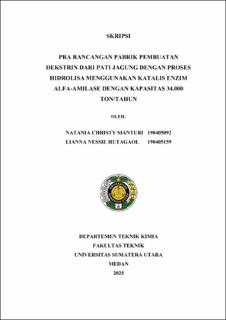Pra Rancangan Pabrik Pembuatan Dekstrin dari Pati Jagung dengan Proses Hidrolisa Menggunakan Katalis Enzim Alfa-Amilase dengan Kapasitas 34.000 Ton/Tahun
Pre Design Plant for the Production of Dextrin From Corn Starch by Hydrolysis Process Using Alpha-Amylase Enzyme Catalyst With Capacity of 34.000 Tons/Year

Date
2025Author
Sianturi, Natania Christy
Hutagaol, Lianna Nessie
Advisor(s)
Sarah, Maya
Metadata
Show full item recordAbstract
Dextrin is an example of a modified starch that is widely needed in the food and pharmaceutical industries, so the demand for dextrin continues to increase. Dextrin is also used in the adhesives, paper, textile, and food and beverage industries, supporting economic, industrial, and environmental sustainability. The process results in changes in starch properties such as initially insoluble in water to dextrin which is easily soluble in cold or hot water, with a real low viscosity, making it easier to use dextrin in high enough concentrations. The increasing need for dextrin in Indonesia can be seen from the increasing number of dextrin imports by Indonesia every year. Therefore, it is necessary to establish a dextrin plant to meet domestic dextrin needs. The plan of dextrin manufacturing plant from corn starch by Hydrolysis Process with production capacity of 34,000 tons/year. The main process in the plant proposal is the hydrolysis of starch into sugar by the enzyme alpha amylase. This process involves alkali and oxidizer. The plant is planned to be located in the Jl. KL. Yos Sudarso, Kec. Medan Deli, Medan City, North Sumatera, with a total land area of 19,812 m², 226 workers are needed, and the business entity will be in the form of a limited liability company (PT.), led by a chief director with a line and staff organizational structure. The establishment and operation of the plant will require an investment capital of IDR 1.886.013.520.125,08 and production costs of IDR 1.509.437.051.307,71, with sales revenue of IDR 1.994.636.429.280,00, resulting in a net profit of IDR 322.712.586.351,58. Based on the economic analysis, this plant has a Profit Margin (PM) of 23.11%, Break-Even Point (BEP) of 34.09%, Return on Investment (ROI) of 17.11%, Return on Network (RON) of 28.52%, Pay Out Time (POT) of 5.8 years (68 months), and an Internal Rate of Return (IRR) of 18.95%. Based on the results of economic analysis, it can be concluded that this plant is feasible to establish.
Collections
- Undergraduate Theses [1239]
